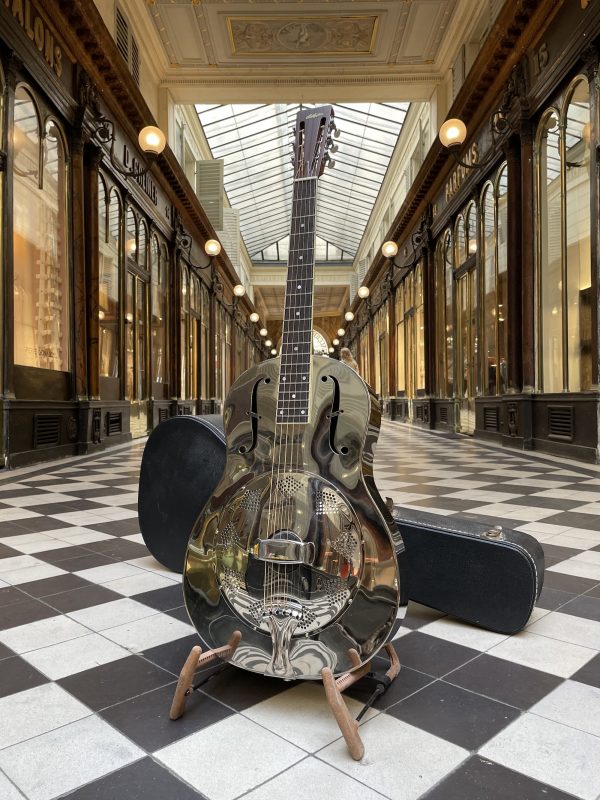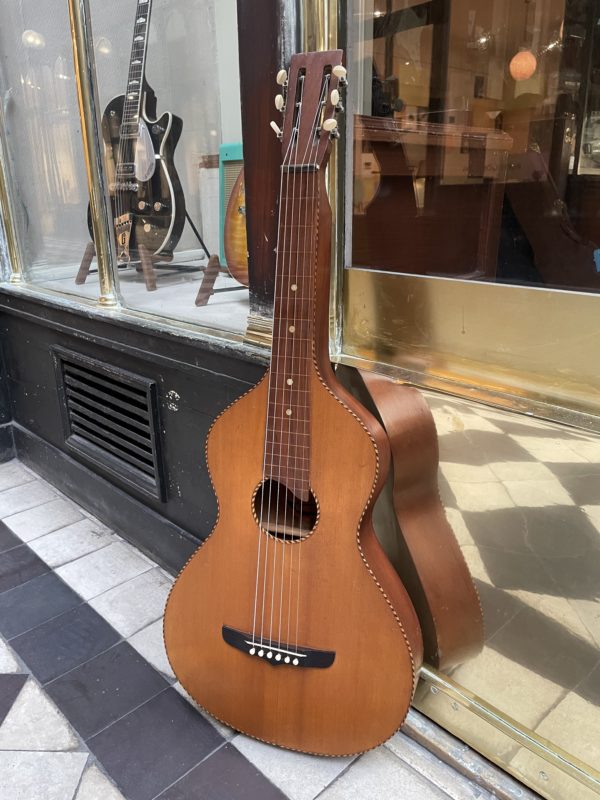Resonator / Slide
THE RESOPHONIC GUITAR
In the 1920s and 30s, while all the instrument builders were focused on increasing the loudness of the guitar by tirelessly expanding its body width, the National and Dobro type guitars offered a radically different mechanical and aesthetic solution: an instrument with steel strings, made of either metal or wood, and fitted with one or several metallic cone-shaped resonators, which they dubbed the “ampliphonic” or “resophonic” guitar.
Despite being very similar in proportions and external looks, the National and Dobro models have mechanical subtleties concerning their resonators which allows us to distinguish two, or even three, different styles of instrument. The tricone resonator is very easily recognizable: it is made up of three small aluminum cones, two placed on the lower string side and one on the high string side, the tops of these cones are connected to one another by a T-shaped metal piece turned sideways. The strings rest on the horizontal portion of the T-bar, which also incorporates the bridge assembly – this is what allows string vibrations to be transmitted into the cones, and thus amplify the guitar’s sound. The single resonator functions mostly in the same way, except that in the place of the three small cones, its resonator system is made of a single large cone covering the entire belly of the guitar. The bridge is maintained by the pressure of the strings on a circular piece of wood known as a “biscuit” placed in the center of the cone. To these two similar types of resonators produced by both National and Dobro, later merged under a single banner, we might consider another type of resonator found on Dobro instruments where the piece of metal that forms the resonator is a spherical bowl with web-like framework inside – in other words, the resonator takes the form of a loudspeaker.
The body of all-metal guitars is made, for the first models, of an alloy of copper, zinc and nickel known as German silver (the same material used for most modern-day fretwork), later models were built from yellow brass or sheet steel. The finish can be either a uniform nickel plating, wood-colored enamel with or without stenciled designs, or richly etched with using a sand-blasting technique, depicting scenes of paradisiacal beaches of the Pacific Islands and their charming inhabitants. Wooden-body instruments are often mahogany, or maple with a spruce top. The two F-shaped soundholes or the two small mesh rosettes are found on the upper body, on either side of the fingerboard. The proportions of all of these guitars are substantially identical from one model to another and, taken as a whole, National and Dobro type guitars present a typical timbre and a particularly powerful volume output (as powerful as they are heavy instruments, according to their detractors). The lap-steel “slide” playing on a Dobro provides unparalleled length of sound, and these instruments primarily used in Hawaiian music will also end up delighting country musicians, as well as penniless bluesmen who are able to pick one up for a handful of dollars at a time when no one wanted to hear about Hawaiian music anymore; it is in itself a textbook case of diverting a guitar from its primary purpose. Less prosaically, one can imagine the rather striking spectacle of a Son House (1902-1988), Bukka White (1909-1977) or Black Ace (1905-1972) who, far away from Honolulu, would recount his misery and his torments on a guitar covered in soft beaches and palm trees, pretty hula dancers and serene clouds.
Lastly, we will gladly mention the name of luthier Mike Lewis, settled in France for more than forty years, specialist of these instruments and creator of the Fine Resophonic brand which boasts an international clientele of true “connoisseurs” – among which Louisiana Red or Eric Clapton…



